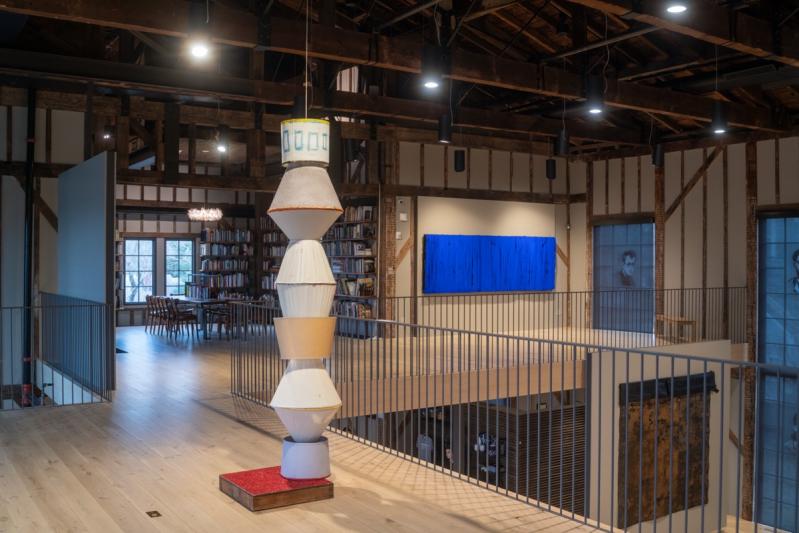For an area steeped in history, looking back a mere couple of decades to place a marker and say, "Here was a significant time," for whatever reason, is rare on the South Fork.
It is one of the reasons why "Return to a Place by the Sea" is eye-opening and powerful. The exhibition, now mounted at The Church in Sag Harbor, revisits an important gallery show from 1999 that featured four Black artists who all had ties to the village's Eastville/SANS enclave and were loosely known as "the Eastville Four."
All respected and successful abstract artists, Nanette Carter, Gregory Coates, Al Loving, and Frank Wimberley were also friends and jazz aficionados. Some 25 years ago, their group exhibition "A Place by the Sea" was shown in Albany and New York City, in addition to the Arlene Bujese Gallery in East Hampton.
The Church is displaying art from that time as well as their more recent work. The examination functions not as a retrospective, but snapshots of then and now. With the exception of Loving, who died in 2005, every artist gets a good two-decade comparison. Loving, who is represented with pieces closer to a decade apart, still demonstrates shifts in style and materials.
His two untitled wall pieces from 1982 are unusual collages of fabric and cut dyed paper in linear, curved, and solid forms. The material acts as both a backing and an active or textural visual element. Laying down a beigey diamond-patterned fabric as ground, he creates a horizon along a midline border of claret-colored velvet. The artist was informed by Color Field painting in his earlier work, but the composition contains an object loosely resembling a spaceship module hovering over a distant planet.
Its partner work has the same outer space feel, except two of the fabrics used are striped, making it difficult to impose any flights of fancy on it. The stripes flatten the surface and make everything on it seem two-dimensional -- even the collage elements that sit on top and project ever so slightly into a third.
His later work from the 1990s removes the background entirely to focus on collaged spiral shapes, placed on paper but cut to fit the composition and strengthened by a plexiglass backing. The visual vocabulary of circles and spirals symbolized "his African roots as well as the notions of growth and renewal," according to The Church.
Loving, who was born in 1935, was an influence on Ms. Carter and Mr. Coates, who are both about a generation younger than he was. Ms. Carter met him at Guild Hall and was the first to show him Sag Harbor, even though he had been coming to the South Fork for several years prior to that. She has not changed her medium (oil) or support (Mylar) over the years, yet her work has shifted from the crispy hard-edged squares that dominate her "Slightly Off Keel" series from the late 1990s. In "The Weight #32" and "Cantilevered #61" there is a freer flow as well as a heightened sense of peril.
Occupied with issues of social injustice, politics, and the disruption that technology and social media have left in their wake, her latest pieces have a sense of oppressiveness as well as an unsustainable imbalance. With minimal visual cues, her work digs deeper into our psyche to mine a more intuitive response.
Ms. Carter, who started spending summers in Sag Harbor when she was 9, shared the same street with Mr. Wimberley, who bought land there in 1964 and built a house that would become a locus for musicians and artists.
He was born in 1926, and his work is influenced by Abstract Expressionism in a way that the other artists in this show are not. With only four paintings on display, there is enough to demonstrate great variety from year to year, canvas to canvas. "Untitled Composition," the earliest work, is a false flag, leading us to assume he has taken any associative reference out of the brooding black and brackish mass radiating out from the upper-left corner.
His other pieces actually have titles, and they are revelatory. "Mud Spirit," from 1997, evokes what is seen there, as do the later "Ribbon Sketch" and "Slight Disturbance." While all of his canvases rely on the build-up of paint for expression, "Slight Disturbance," the most recent of the lot, has a real physical presence. The paint is so layered and built up in spots that it seems tactile and somewhat three-dimensional, not unlike Loving's work. Mr. Wimberley's tendency to leave previous layers vaguely exposed makes his compositions function like palimpsests, offering depth and clues to their previous iterations.
Mr. Coates, the youngest of the group, was given the push he needed to rethink his approach to art-making by Loving. Trained as a painter at prestigious art schools in Washington, D.C., and Dusseldorf, Germany, he began to pursue a more physical expression of texture, shape, and light. According to The Church, the mentor told his protege, "There's your art there!" when he saw Mr. Coates's first collage of wood, metal, and cardboard.
Although the artist still uses color the way a painter might, his materials and mediums vary widely as they are almost all found objects. His recent work in the show uses rubber sheeting as a wall hanging and lampshades to mimic a sculptural form that might have come out of Constantin Brancusi's studio. "(Some) of My Friends Are Dead," the rubber sheet, is in the process of decay. Bits of surface crack and slough off to collect on the floor, making the piece seem alive, or at least active in its decomposition.
Installed directly above the rubber work, on the mezzanine level, is an older piece by Mr. Coates. "Iona Deep Blue," from 1990, is a "canvas" formed by rubber innertubing wrapped around wooden pallets. The rubber and the exposed areas of the wood are painted a deep and lively "Klein blue," an intentional nod to the influential French conceptual artist Yves Klein. A smaller work in the installation from 1998 demonstrates how much more important paint was in the earlier works and how the artist has since favored minimal intervention as he continues to reference art historical themes and tropes.
The exhibition will be at The Church through May 27.




